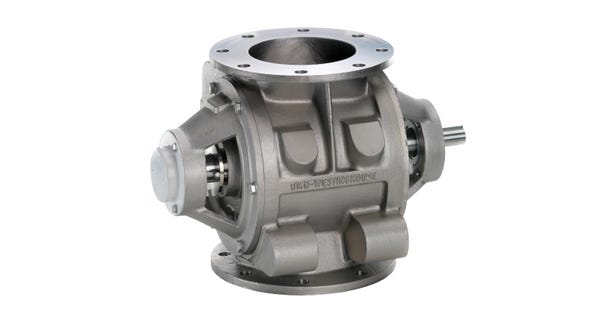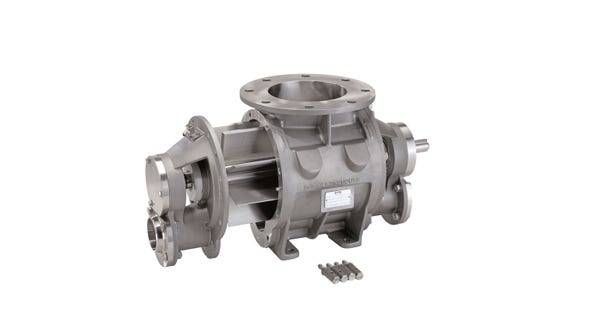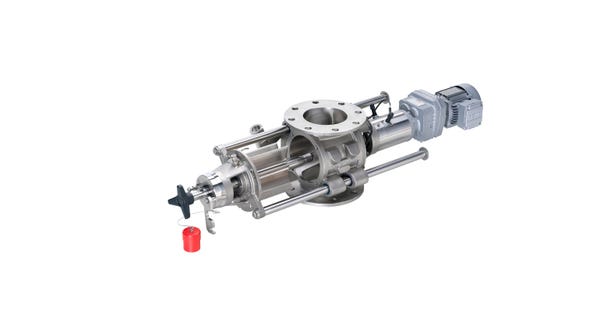April 25, 2019

In a sanitary application, a rotary valve’s design and construction materials must meet hygienic standards to ensure that the product reaches the customer without contamination. This article explains how you can select a rotary valve that matches your application’s hygiene requirements.
Every year, tens of millions of people are affected by contaminated food supplies containing bacteria such as E. coli and salmonella. The resulting product recalls can be costly to the manufacturer’s bottom line and reputation. These realities make it important to evaluate and categorize the contamination risks in handling food products. At minimum, your rotary valves and other material handling equipment must comply with the regulatory hygiene requirements in the country where your food product is manufactured
Three well-known independent organizations have developed standards for designing equipment for hygienic applications: United States Department of Agriculture (USDA), 3A Sanitary Standards Inc., and European Hygienic Engineering & Design Group (EHEDG). Their standards are accepted around the world. The following information covers the minimum, midlevel, high-level, and highest-level hygiene requirements for rotary valves handling food products in sanitary applications.
Minimum Hygiene Requirement
In general, the minimum hygiene requirement for a rotary valve in a sanitary application is that all of the valve’s product-contact surfaces be made of FDA-approved materials. These include AISI 304 and AISI 316 grades of stainless steel, which have relatively low cost, are strong and resist corrosion, as well as FDA approved plastics, polymers, and rubbers. The minimum hygiene requirement permits aluminum or mild steel construction for nonproduct contact surfaces. Aluminum or mild steel surfaces are usually plated, painted, or powder coated to protect them from corrosion.
Following the minimum hygiene requirement is often acceptable for a rotary valve in a sanitary application in which the product will be further processed with heat. Examples are a food ingredient like ground coffee, which will be brewed later, or sugar or flour, which will be baked or cooked later. Such a valve is used in a dry environment and normally doesn’t require frequent cleaning.

The rotary valve commonly used to meet the minimum hygiene requirement in sanitary applications is a valve with a fixed-vane, chamfered (beveled-edge) rotor. An example can be seen in Figure 1. The minimum hygiene requirement for this type of valve, normally allows the inlet and outlet to be left as cast (without further finishing) and generally requires surface finishes for the valve’s machined product-contact parts to be around 3.2 Ra. For applications requiring regular valve cleaning, select a valve with an easy detachable rotor to facilitate dry cleaning. To clean the valve, remove the end cover opposite the valve’s drive, remove and clean the rotor, and then use a vacuum cleaner to remove product from the valve interior and shaft-sealing assembly. You should not use a compressed-air hose to clean the valve because it can spread product and contaminate the surrounding area. Use wet sanitary wipes to remove any remaining product, and then dry the valve before reassembling it and putting it back into use.
Mid-Level Hygiene Requirement
Dry cleaning. A common sanitary application requiring a rotary valve meeting mid-level hygiene requirement is conveying dried milk powder or another food powder from a silo to a packaging machine or other process destination. A valve in such an application requires dry cleaning more often than a minimum-hygiene valve. The required frequency will depend on your product and process. To meet the mid-level hygiene requirement, the rotary valve must have a fixed-vane rotor with a radius machined between the vanes, and the vanes should be chamfered on three sides. An example can be seen in Figure 2. All of the valve’s product contact parts--including the inlet and outlet--must be machined or polished to 0.8 Ra (180 grit) and be free of pinholes and crevices. To facilitate cleaning, the valve interior should have no sharp corners. Instead, all corners should have a radius of at least 0.8 mm.
When the valve requires cleaning, you must first remove the drive-side end cover and remove the rotor (called out-of-place cleaning or COP). After this, the dry-cleaning procedure is the same as that for the minimum hygiene requirement. You can simplify the cleaning procedure by choosing a valve with slide rails or bars mounted on its exterior. The rail design supports the non-drive side end cover and allows you to easily remove the rotor and end cover without damaging the housing or rotor blades. The stability of the extraction mechanism ensures accurate alignment and tight clearances. Moreover, the rail support system increases operator safety and gives line operators considerable flexibility in cleaning the equipment between runs. On a large valve, slide rails are especially important because the components withdrawn from the valve will be heavier. Slide rails are shown on the valve in Figure 3.

Wet cleaning. Discharging a food powder produced from a wet mix in a spray dryer is a typical sanitary application for a rotary valve that must meet the mid-level hygiene requirement and can require wet cleaning. To select a rotary valve for this hygiene level, start by following the same mid-level hygiene guidelines for a valve that requires dry cleaning, including using the same construction materials and finishes.
To ensure that the valve can withstand wet cleaning, follow these additional guidelines: Make sure that any cracks, crevices, and other areas on the valve exterior where product may accumulate are sealed with an FDA-approved silicone or epoxy sealant. Prevent rust or flaking of the coatings by using stainless steel guards and fittings wherever possible. Choose a valve with bearings that are protected from cleaning liquids. Ensure that the valve’s drive-side end cover is fitted with an O ring or gasket, so that if the valve is cleaned without removing the drive-side cover, no product or cleaning liquid can enter between the metal cover and housing surfaces and cause contamination. Examples of mid-level hygiene rotary valves equipped for wet cleaning are shown in Figure 3.
This valve typically requires more frequent cleaning than a mid-level-hygiene valve that requires dry cleaning. Whether your valve requires a COP or cleaning-in-place (CIP) procedure and which wet-cleaning steps it will require will depend on your product and process. A typical COP wet-cleaning cycle includes these steps: Remove the non-drive-side end cover and rotor, place a dummy shaft between the end covers, and close the valve. Clean the rotor. Next, rinse the valve several times with a series of liquids, in this order: warm water, a caustic liquid, warm water, a liquid with a low acid concentration, a very large amount of water, a disinfectant, and, finally, clean water with a low bacteriological contamination (often tap water, sometimes with an added sanitizer). Remove the non-drive-side end cover and dummy shaft, clean both shaft sealing areas, and then replace the cleaned rotor and reassemble the end cover. After these steps, dry the valve with hot air. The wet-cleaning CIP procedure requires a CIP-equipped rotary valve that doesn’t have to be removed or disassembled for cleaning, and cleaning is automatically controlled without operator involvement. The typical CIP cleaning procedure would include the same liquids and drying process as for CIP cleaning elsewhere in the plant.
High-Level Hygiene Requirement (Wet Cleaning)
If your rotary valve handles perishable food products and, in particular, dry-milk-based products, it must meet the high-level hygiene requirement and be certified to the regulatory standards for your industry (such as the USDA Dairy Division for handling milk powders). This hygiene level can require an intensive wet-cleaning process that often includes the use of acidic, alkaline, or caustic chemical cleaning solutions and sanitizers and manual scrubbing of the valve components. The valve’s cleaning frequency depends on your product and process. When selecting a high-level-hygiene rotary valve, you can follow the same guidelines listed for the mid-level-hygiene valve. Also ensure that the rotary valve’s wet-cleaning requirement is accepted by an independent third-party organization (such as the USDA or EHEDG) that inspects and validates valve component designs according to specific criteria.
Highest-Level Hygiene Requirement (CIP Wet Cleaning)
A rotary valve that must meet the highest-level hygiene requirement can be equipped for automatic CIP wet cleaning and can also be fitted with a complete stainless-steel-geared direct drive. Such a valve’s end covers will have O rings or gaskets, and the valve should have shaft seals equipped for CIP. This valve can handle the same applications listed for the high-level hygiene requirement but operates in a fully automated conveying system and allows wet cleaning without a need to open and disassemble the valve for cleaning and without requiring an operator’s involvement. This not only eliminates cleaning labor costs and the risk of damaging the valve but prevents bacteria and other contaminants from being able to enter it. The automated CIP method is also more reliable than manual wet cleaning and can be validated to demonstrate that the valve is properly cleaned according to your hygiene requirement. Ensure that you select a CIP rotary valve certified by a third-party organization to confirm that the valve has been tested and validated by that organization.
DMN-Westinghouse has been designing and manufacturing rotary valves, diverter valves and other related components for the bulk solids handling industry for more than 40 years. For more information, call 870-733-9100 or visit www.dmnwestinghouse.com.
About the Author(s)
You May Also Like




